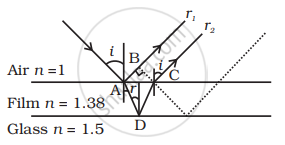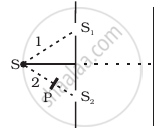Advertisements
Advertisements
प्रश्न
To ensure almost 100 per cent transmissivity, photographic lenses are often coated with a thin layer of dielectric material. The refractive index of this material is intermediated between that of air and glass (which makes the optical element of the lens). A typically used dielectric film is MgF2 (n = 1.38). What should the thickness of the film be so that at the center of the visible spectrum (5500 Å) there is maximum transmission.
उत्तर
Consider a ray incident at an angle i. A part of this ray is reflected from the air-film interface and a part is refracted inside. This is partly reflected at the film-glass interface and a part transmitted. A part of the reflected ray is reflected at the film-air interface and a part is transmitted as r2 parallel to r1. Of course, successive reflections and transmissions will keep on decreasing the amplitude of the wave. Hence rays r1 and r2 shall dominate the behaviour. If the incident light is to be transmitted through the lens, r1 and r2 should interfere destructively. Both the reflections at A and D are from lower to higher refractive index and hence there is no phase change on reflection. The optical path difference between r2 and r1 is n (AD + CD) – AB.
If d is the thickness of the film, then
`AD = CD = d/cos r`
`AB = AC sin i`
`(AC)/2` = d tan r
∴ `AC = 2d tan r`
Hence, `AB = 2d tanr sini`
Thus the optical path difference is

`2n d/cos r - 2d tan r sin i`
= `2. sin i/sin r d/cos r - 2d sinr/cos r sin i`
= `2d sin [(1 - sin^2r)/(sinr cos r)]`
= `2 nd cos r`
For these waves to interfere destructively this must be `λ/2`.
⇒ `2nd cos r = λ/2`
or `nd cos r = λ/4`
For a camera lens, the sources are in the vertical plane and hence `i ≃ r ≃ 0`
∴ `nd ≃ λ/4`
⇒ `d = (5500 Å)/(1.38 xx 4) ≃ 1000 Å`
APPEARS IN
संबंधित प्रश्न
Draw a neat labelled diagram showing the plane of vibration and plane of polarisation for polarised light.
What is the Brewster angle for air to glass transition? (Refractive index of glass = 1.5)
The refractive indices of water for red and violet colours are 1.325 and 1.334 respectively.
Find the difference between the velocities of rays for these two colours in water. (c = 3 × 108 m/s)
Show using a proper diagram how unpolarised light can be linearly polarised by reflection from a transparent glass surface.
Green light is incident at the polarising angle on a certain transparent medium. The angle of refraction is 30° . Find
(i) polarising angle, and
(ii) refractive index of the medium.
Light transmitted by Nicol prism is ______.
What is a polariser?
What is plane polarised light?
What is the angle of polarisation and obtain the equation for an angle of polarisation?
Figure shown a two slit arrangement with a source which emits unpolarised light. P is a polariser with axis whose direction is not given. If I0 is the intensity of the principal maxima when no polariser is present, calculate in the present case, the intensity of the principal maxima as well as of the first minima.

